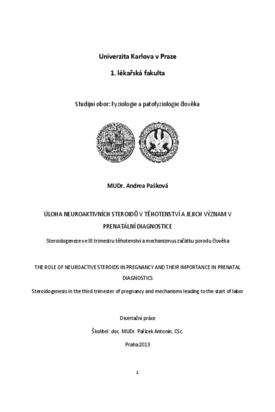Úloha neuroaktivních steroidů v těhotenství a jejich význam v prenatální diagnostice
The role of neuroactive steroids in pregnancy and their importance in prenatal diagnosticsSteroidogenesis in the third trimester of pregnancy and mechanisms leading to the start of labor
dizertační práce (OBHÁJENO)

Zobrazit/
Trvalý odkaz
http://hdl.handle.net/20.500.11956/52935Identifikátory
SIS: 137497
Kolekce
- Kvalifikační práce [4323]
Autor
Vedoucí práce
Oponent práce
Procházka, Martin
Tošner, Jindřich
Fakulta / součást
1. lékařská fakulta
Obor
-
Katedra / ústav / klinika
Gynekologicko-porodnická klinika 1. LF UK a VFN v Praze
Datum obhajoby
12. 12. 2013
Nakladatel
Univerzita Karlova, 1. lékařská fakultaJazyk
Čeština
Známka
Prospěl/a
Klíčová slova (česky)
steroidy, porod, GC-MS, enzymy steroidogeneze, pupečníková krevKlíčová slova (anglicky)
steroids, labor, GC-MS, enzymes of steroidogenesis, umbilical bloodSteroidní hormony účinkují dvěma způsoby. Klasický účinek na genomové úrovni nastupuje relativně pomalu, v hodinách až dnech. Naopak negenomové účinky steroidů mohou ovlivnit buněčné pochody během sekund či dokonce milisekund. V průběhu těhotenství se uplatňují oba mechanismy. Steroidní hormony, které působí negenomově a ovlivňují neuronální excitabilitu, se nazývají neuroaktivní steroidy. Cílem této práce bylo stanovení hladin steroidních hormonů a zkoumání jejich vztahu k fyziologii a patofyziologii těhotenství. Fyziologický význam zvýšení placentární tvorby progesteronu, snížení produkce 5β-pregnanových steroidů a rostoucí aktivita steroidních sulfotransferáz s gestační věkem jsou podrobně diskutovány. Na základě námi získaných výsledků byl navržen alternativní mechanismus syntézy mateřského progesteronu v těhotenství (progesteron, resp. gestageny stabilizují činnost myometria = udržení těhotenství). Na rozdíl od dřívějších sdělení naše pozorování popisují vznik gestagenů z prekurzorů ze strany plodu (z pregnenolon sulfátu). Tento mechanismus je úzce spojen s distribucí placentárních oxidoreduktáz. Příslušná data této práce ukazují na rostoucí trend směrem k přeměně 3-oxo-(3β-hydroxy-), 17-oxo- a 20-oxo-steroidů na jejich 3α-hydroxy-, 17β-hydroxy- a 20α-hydroxy-metabolity. Z toho vyplývá, že...
Steroid hormones act through two mechanisms. The first is the classical genomic level, which acts at a relatively slow pace from hours to days. The second non-genomic mechanism of steroid activity can influence cellular function during seconds or even milliseconds. During pregnancy both mechanisms take place. Steroid hormones that act non-genomically and influence neuronal excitability are called neuroactive steroids. The aim of this study was to measure the levels of steroid hormones and examine their relationship to the physiology and pathophysiology of pregnancy. The physiological importance of increased placental progesterone production, lowered production of 5B-pregnanone steroids and increased activity of steroid sulfotransferase with gestational age have been intensely discussed. On the basis of our results, we have proposed an alternative mechanism of maternal progesterone synthesis during pregnancy (progesterone, or the gestagen stabilizing activity of the myometrium = continuation of pregnancy). In contrast to previous results our observations indicate that gestagens arise from precursors in the fetus (from pregnenolone sulfate). This mechanism is closely connected with the distribution of placental oxido-reductase. Data from this study show an increasing trend in the conversion of...
